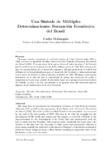
Please use this identifier to cite or link to this item:
http://ricaxcan.uaz.edu.mx/jspui/handle/20.500.11845/431Full metadata record
| DC Field | Value | Language |
|---|---|---|
| dc.contributor.other | 0000-0001-7195-8775 | es_ES |
| dc.coverage.spatial | Brasil | es_ES |
| dc.creator | Mallorquin, Carlos | - |
| dc.date.accessioned | 2017-09-06T19:38:52Z | - |
| dc.date.available | 2017-09-06T19:38:52Z | - |
| dc.date.issued | 2009-12-01 | - |
| dc.identifier | info:eu-repo/semantics/publishedVersion | es_ES |
| dc.identifier.issn | 1517-7580 | es_ES |
| dc.identifier.uri | http://hdl.handle.net/20.500.11845/431 | - |
| dc.description | The essay tries to reconstruct the theoretical evolution of Celso Furtado between 1954 and 1959 as well as the appearance of his classic work Formación Económica del Brasil (1959). The birth of what is called Furtado’s “structuralism” can be traced by the end of the last months of 1959. This has to do with his struggles for the development of the north east region and the country, a period in which he is the Superintendent for the development of the North East and subsequently with the task to undertake the Brazilian 1963 economic plan. Insistently the essay puts a lot of effort in the idea that the centrality to think power and asymmetric relations is what makes possible the admirable achievement of Furtado’s structuralist perspective which in turn it obliges us to go a little further searching to supersede some of the limitations of the work discussed. | es_ES |
| dc.description.abstract | El ensayo intenta reconstruir la evolución teórica de Celso Furtado entre 1954 y1959, así como la aparición del libro clásico de Celso Furtado Formación Económica del Brasil (1959). El surgimiento de lo que se llama el “estructuralismo” de Furtado puede establecerse en las postrimerías de los últimos meses de 1959. Esto tiene mucho que ver con sus luchas por el desarrollo regional y del país, periodo en el cual él está al frente de la Superintendencia para el desarrollo del Nordeste y subsecuentemente con la tarea de realizar el plan económico brasileño de 1963. El ensayo pone mucha insistencia en la idea de que la centralidad de pensar las relaciones de poder y asimetrías es lo que hace posible el admirable logro en la perspectiva estructuralista de Furtado, lo cual a su vez, nos impone ir un poquito más allá buscando superar algunas de las limitaciones en la obra discutida. | es_ES |
| dc.language.iso | por | es_ES |
| dc.publisher | Elsevier | es_ES |
| dc.relation | http://www.anpec.org.br/revista/ | es_ES |
| dc.relation.uri | generalPublic | es_ES |
| dc.rights | openAccess | es_ES |
| dc.rights.uri | http://creativecommons.org/licenses/by-nc-sa/3.0/us/ | * |
| dc.source | Economia, Selecta, Brasília (DF), vol..10, no.4, dezembro, pp.905–933. | es_ES |
| dc.subject.classification | CIENCIAS SOCIALES [5] | es_ES |
| dc.subject.other | info:eu-repo/classification/Furtado | - |
| dc.subject.other | info:eu-repo/classification/Estructuralismo | - |
| dc.subject.other | info:eu-repo/classification/Obstáculos Estructurales | - |
| dc.subject.other | info:eu-repo/classification/Desarrollo | - |
| dc.subject.other | info:eu-repo/classification/Centro-Periferia | - |
| dc.title | Una síntesis de múltiples determinaciones: formación económica del Brasil | es_ES |
| dc.type | info:eu-repo/semantics/article | es_ES |
| Appears in Collections: | *Documentos Académicos*-- UA Estudios del Desarrollo | |
Files in This Item:
| File | Description | Size | Format | |
|---|---|---|---|---|
| Mallorquín - 2009 - Una Síntesis de Múltiples Determinaciones Formación Económica del Brasil.pdf | 308 kB | Adobe PDF |  View/Open |
This item is licensed under a Creative Commons License
